Blog Content
20
Oct
2025
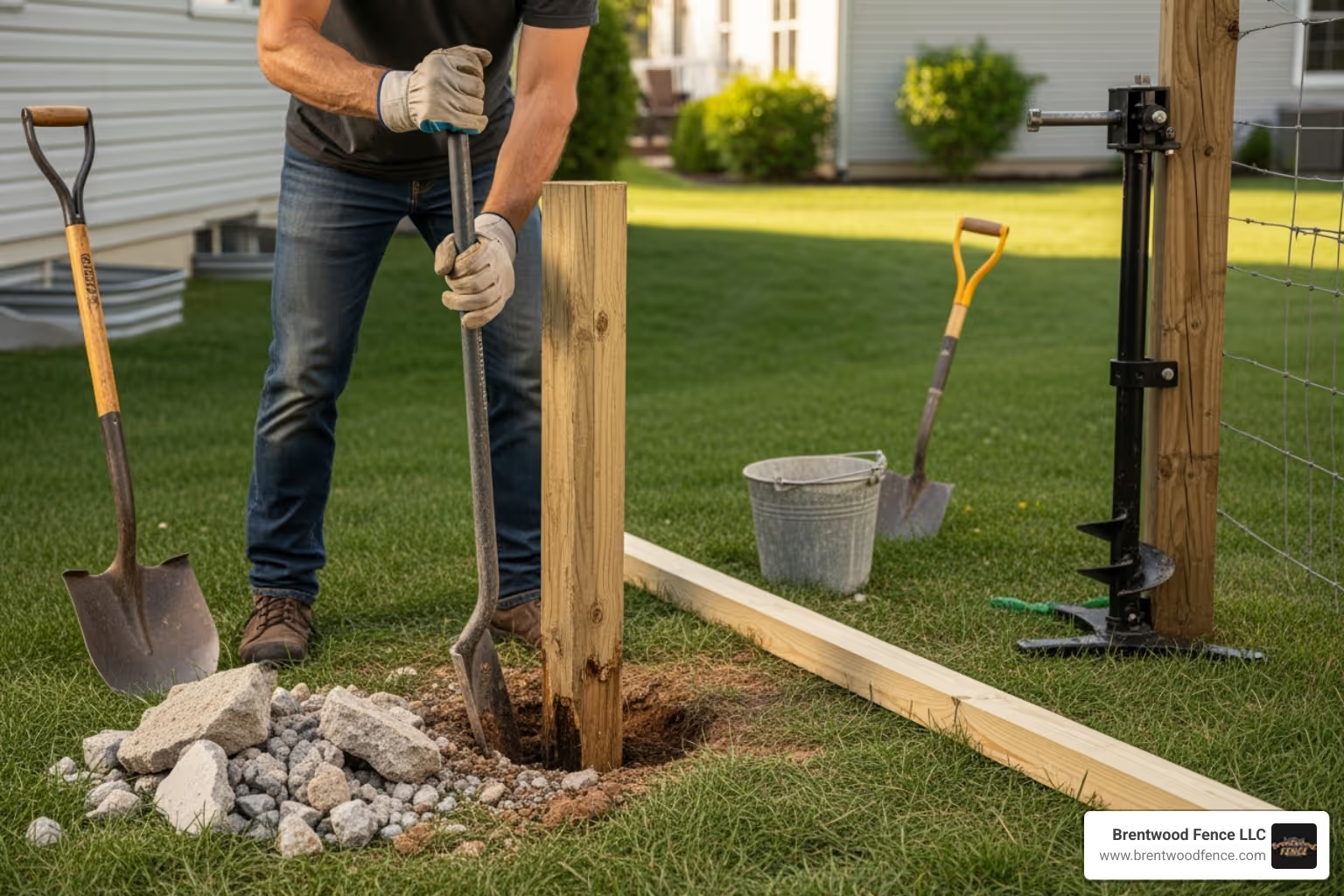
Replacing a wooden fence post might seem like a straightforward DIY task, but getting it wrong can compromise your entire fence's stability and cost you more in the long run. When one fence post fails, it creates a domino effect that can damage adjacent panels and leave your property vulnerable.
Quick Answer for Professional Fence Post Replacement:
A single rotted or leaning post undermines your fence's security and appearance. Professional installation ensures the job is done right the first time, using proper techniques that account for local soil conditions, frost lines, and drainage requirements.
The difference between a quick fix and a lasting solution comes down to following proven methods. Professionals use the right tools, materials, and techniques to create a fence post installation that can withstand decades of weather and use.
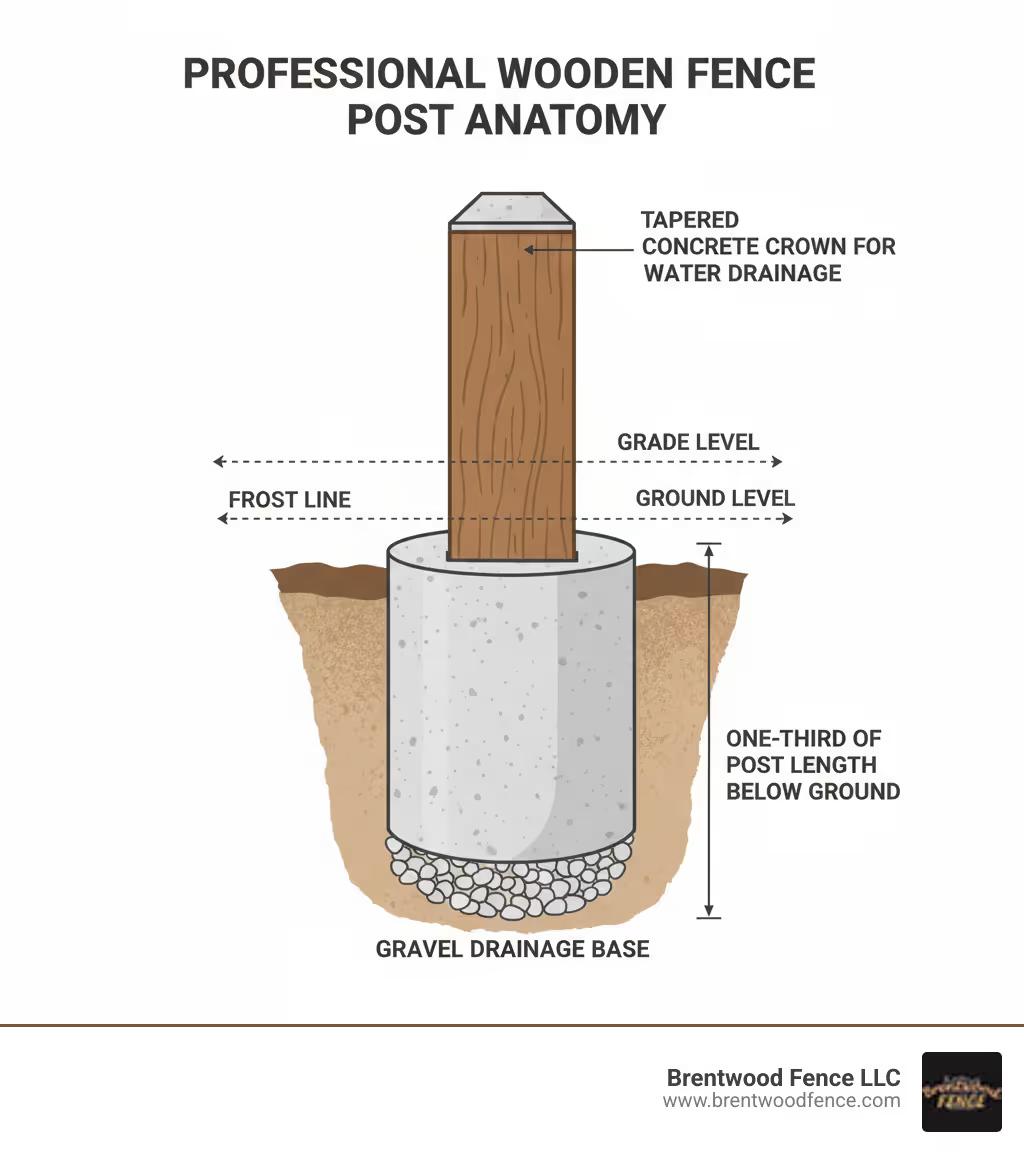
Replacing a wooden fence post further reading:
When you notice a damaged fence post, it's important to assess whether it needs a simple repair or a full replacement. Not every damaged fence post needs the full treatment. A skilled repair can often restore a post, but patching a severely compromised one is a temporary fix at best.
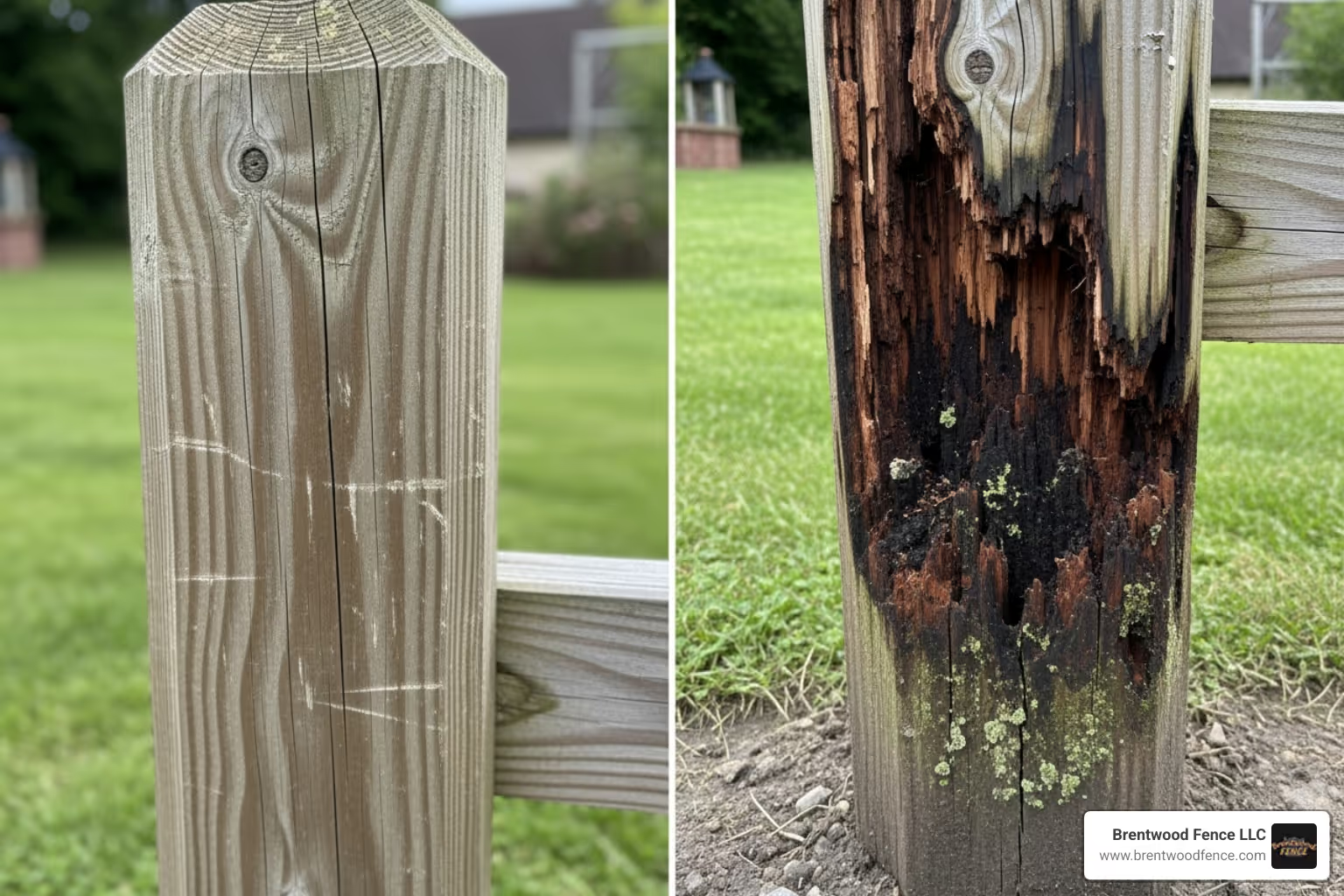
The key is knowing what to look for. Minor wobbling might seem alarming, but if the wood is solid and the footing is intact, a professional can often reset or reinforce it. Small cracks or surface splits that haven't reached the post's core can usually be sealed and treated.
Even slight leaning doesn't automatically mean replacement. If the wood is healthy and the lean isn't severe, there's a good chance we can straighten the post.
However, some issues demand a full replacement. When we see severe rot or decay—especially soft, crumbling wood at ground level—it's time for replacing a wooden fence post entirely. Rot spreads, so trying to save a post that's more than 30% compromised is not a viable long-term solution.
Large, deep cracks that run through the post's core are another red flag, indicating structural failure. The same goes for significant leaning that suggests the post has lost its stability.
Termites, carpenter ants, and other wood-boring insects can destroy a post from the inside out. Sawdust-like debris or small holes are signs of an infestation that undermines your fence's foundation.
When the concrete footing itself starts cracking, crumbling, or heaving from frost, it's a foundation problem that requires a complete do-over. A visibly broken or snapped post also requires replacement.
In New Hampshire, Massachusetts, and Maine, our harsh seasons can turn minor issues into major problems. We recommend a professional assessment to determine the best course of action.
Our experienced team knows what to look for and can save you money by recommending repairs when they'll work—and being honest when replacement is the only safe, long-term solution. For expert guidance, check out our Fence Repair Services NH, MA, ME to keep your fence strong and secure.
When replacing a wooden fence post, every step matters. Precision, the right tools, and experience make the difference between a quick fix and a lasting solution. Skipping crucial steps leads to wobbly posts and damaged panels. Homeowners in New Hampshire, Massachusetts, and Maine trust Brentwood Fence LLC because our proven protocols ensure your new post will stand strong for decades.
Working with a professional Fence Repair Company NH, MA, ME means you get specialized equipment and techniques to avoid costly mistakes that can turn a single post replacement into a major repair project.
The trickiest part of replacing a wooden fence post is removing the old one without damaging the surrounding fence. First, we brace the adjacent panels and rails with temporary supports. This crucial step prevents a domino effect of falling panels when the old post is removed.
Next, we methodically disconnect all attached rails and panels, salvaging hardware when possible. For severely rotted posts, we may use a reciprocating saw, taking care to preserve the surrounding wood.
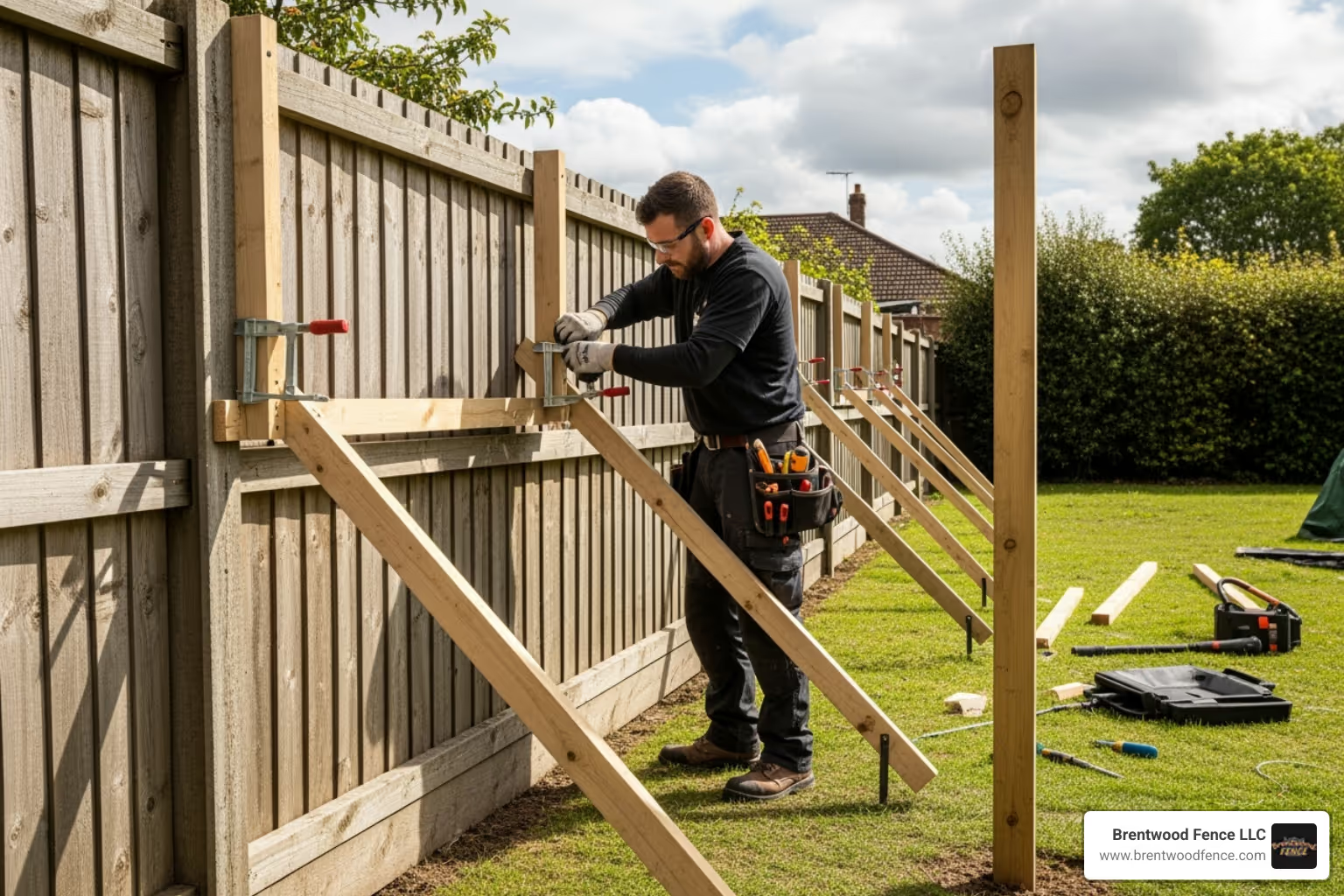
We then dig around and expose the concrete footing. We use leverage techniques with heavy-duty digging bars or high-lift jacks to extract the post and its entire concrete footing. Finally, we break up and remove all the old concrete using sledgehammers and cold chisels. Leaving old concrete behind creates weak spots and compromises the new post's foundation.
Once the old post is removed, we prepare the hole for the new one. Proper hole preparation is critical. We follow the rule of digging to the correct depth: burying at least one-third of the post's total length. For a standard 6-foot fence, we dig at least 2 feet down.
Local knowledge of the frost line is also crucial. In New England, frost can penetrate 3 to 4 feet deep. We always dig below this line to prevent frost heave, where expanding frozen ground pushes posts out of alignment.
Proper hole diameter is also important. We make the hole about three times wider than the post. This allows for a substantial concrete collar that anchors the post to the surrounding soil. Finally, we clear all debris from the hole for better concrete adhesion and drainage.
Setting a post correctly requires attention to detail. We start by adding a gravel drainage base (four to six inches of crushed stone) to the bottom of the hole. This provides crucial drainage, preventing water from pooling at the base of the post, which is the leading cause of rot.
For the new post, we use pressure-treated lumber engineered to resist rot and insects. We often apply an additional coat of wood preservative to the underground portion for extra protection.
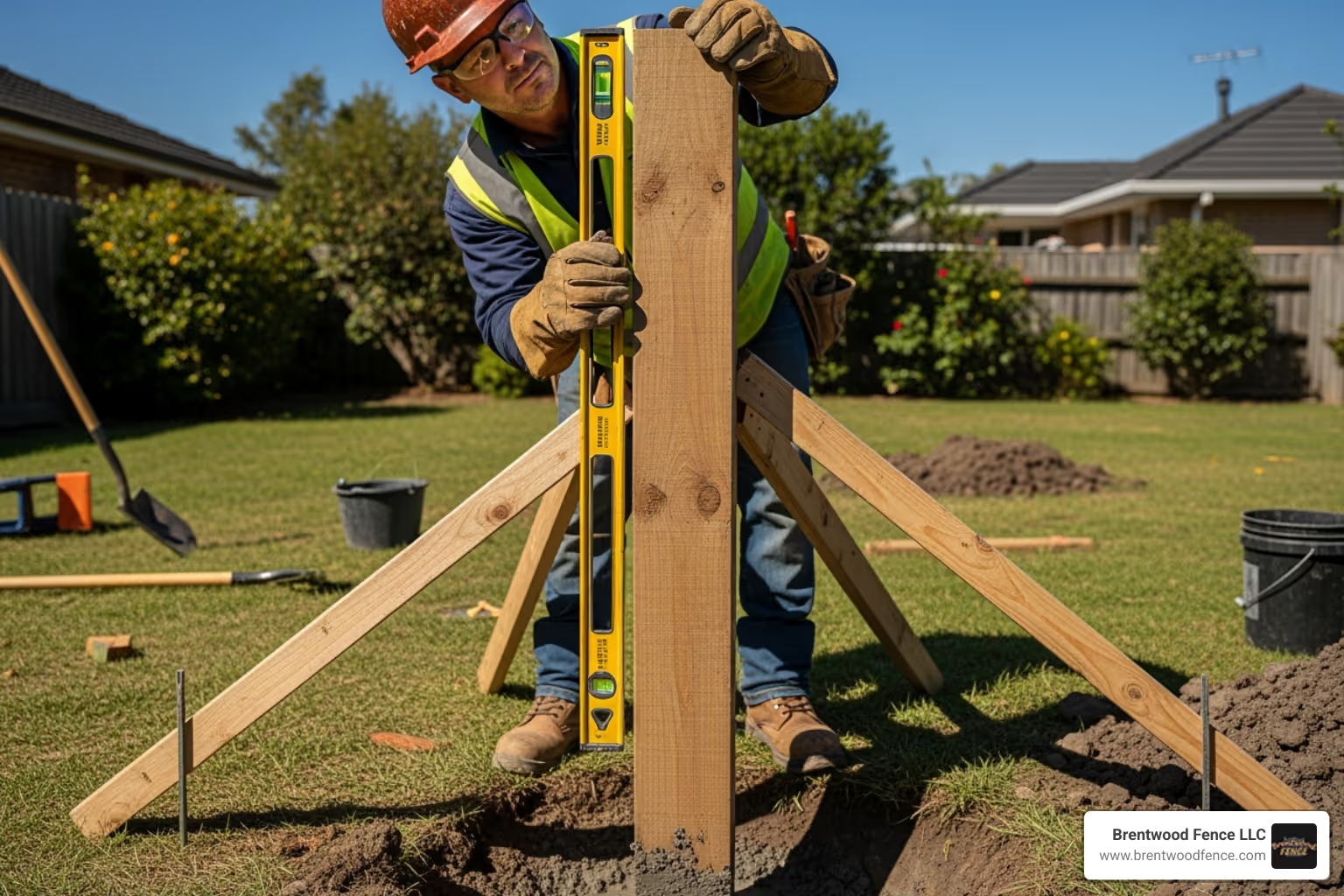
We then use a 4-foot level to ensure the post is perfectly plumb, checking from multiple angles. Understanding What Do Level and Plumb Mean? is fundamental to professional fence work. Temporary bracing with diagonal stakes and string lines holds the post in perfect alignment while the concrete sets. These extra steps are essential for a professional installation that remains straight and secure.
When it comes to replacing a wooden fence post, the foundation you create will determine whether your fence stands strong for decades or starts wobbling within a few years. Think of it this way: you wouldn't build a house on a shaky foundation, and your fence deserves the same level of care and attention.
We've seen too many fence posts fail because corners were cut during installation. That's why we focus on proven methods that guarantee your investment will last through New England's harsh winters and stormy summers.
There's a reason concrete has been the go-to choice for fence professionals for generations. When installed correctly, it creates an unshakeable anchor that can withstand everything Mother Nature throws at it.
Why concrete delivers best strength becomes clear when you consider the forces acting on your fence. Wind loads, soil movement, frost heave, and even the occasional bump from a lawnmower all try to push your post out of alignment. Concrete effectively locks your post in place, creating a solid foundation that resists these forces.
This is especially critical for gateposts, corner posts, and end posts that bear extra weight and stress. For a standard 6 to 8-foot fence, we ensure the concrete footing extends deep enough to provide optimal support, following the proven techniques demonstrated in How Do I Set a Post in Concrete?.
Choosing between fast-setting and standard concrete depends on your project timeline and conditions. We typically use fast-setting concrete for efficiency, which allows us to move forward with your project without lengthy delays. The beauty of fast-setting concrete is that it reaches working strength in just 20-40 minutes, though we always allow extra curing time for maximum durability.
Proper mixing and pouring technique makes all the difference in the final result. We mix the concrete to a thick, oatmeal-like consistency that flows well but isn't soupy. As we pour it into the hole around your perfectly plumb post, we use a tamping rod to eliminate air pockets that could create weak spots in the footing.
The secret to preventing future rot lies in how we finish the concrete surface. We create what's called a "crown" – concrete that extends slightly above ground level and slopes away from the post on all sides. This seemingly small detail is actually huge for your post's longevity, as it directs rainwater away from the wood instead of letting it pool around the base.
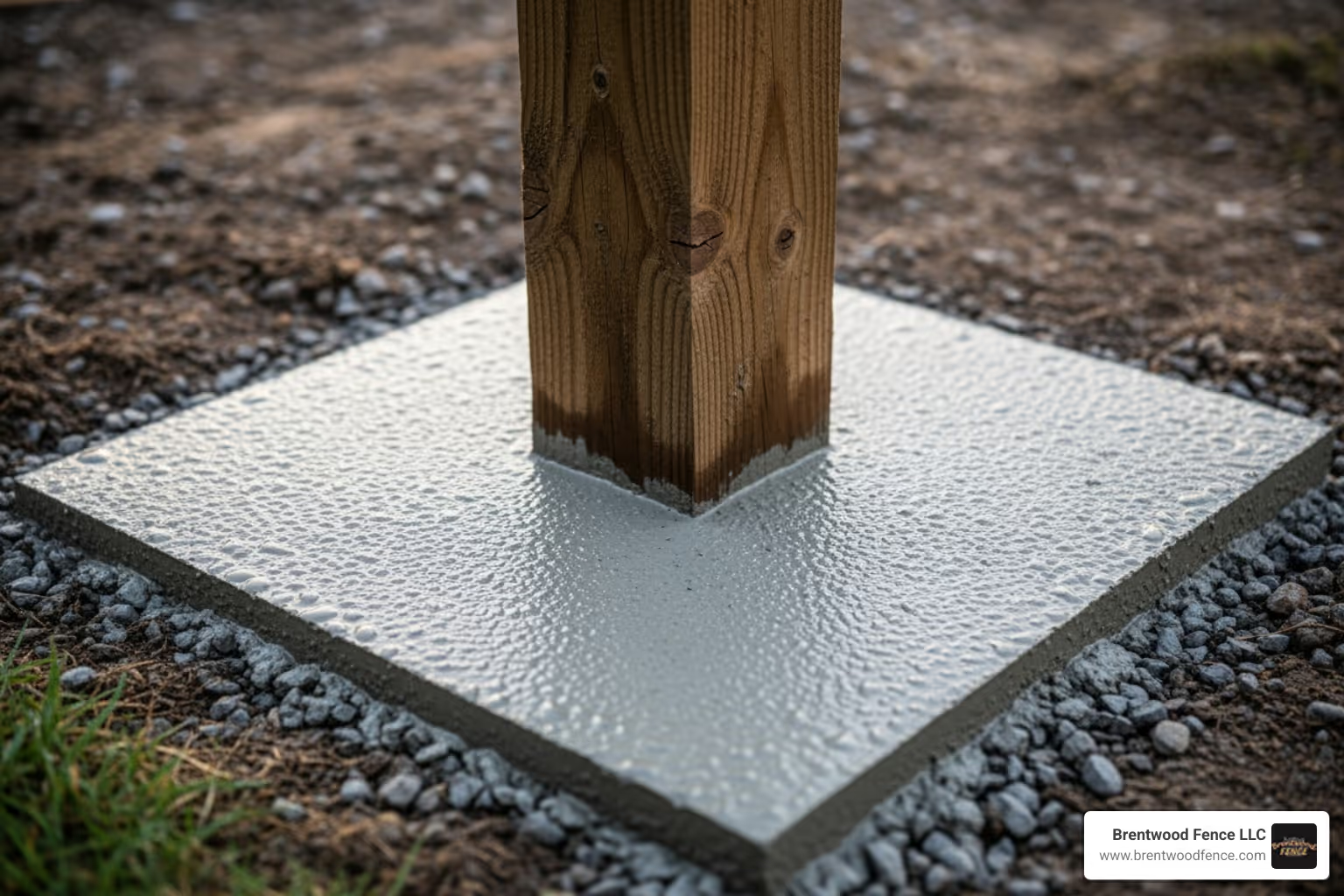
We always allow the concrete to cure for at least 24-48 hours before removing temporary braces and reattaching fence panels. Patience at this stage pays dividends in the form of a rock-solid fence that will serve you well for years to come.
While concrete remains our preferred method for most installations, we understand that every situation is unique. Sometimes soil conditions, budget constraints, or specific fence types call for alternative approaches.
Gravel and soil packing can work well for lighter fence styles like split-rail or decorative picket fences. This method involves carefully layering gravel and compacted soil around the post. The key is thorough compaction – we pack the material in 6-inch lifts, ensuring each layer is solid before adding the next.
Soil type makes a huge difference with this method. In sandy soil, the gravel helps create stability, while in heavy clay, we might use mostly gravel to improve drainage around the post. However, this approach requires more maintenance over time and won't provide the same long-term stability as concrete.
Expanding foam anchors offer speed and convenience, which makes them tempting for quick fixes. The foam sets rapidly and can provide reasonable support for lightweight applications. However, we rarely recommend foam for new fence installations because it simply can't match concrete's strength and durability, especially for posts that will bear significant loads or face high winds.
Metal post spikes represent the quickest installation method – just drive them into the ground and insert your wooden post. While this works for temporary or very light fences, the limitations are significant. Spikes can shift over time, don't work well in rocky soil, and provide minimal resistance to lateral forces.
For any serious replacing a wooden fence post project where you want lasting results, we consistently recommend concrete footings. The small additional investment in materials and time pays for itself many times over in durability and peace of mind. Your fence is protecting your property and privacy – it deserves a foundation that won't let you down.
A professional job doesn't end when the concrete is poured. The final steps ensure a seamless look and a longer lifespan for your entire fence. Think of it like finishing a puzzle – every piece needs to fit perfectly to create the complete picture.
Once the concrete has had time to cure properly (usually 24-48 hours), we can move forward with the exciting part – putting your fence back together. This is where all our careful preparation pays off.
Aligning rails perfectly is crucial for both appearance and structural integrity. We take extra time to ensure each horizontal rail lines up exactly with its pre-drilled attachment points on the new post. A fence that looks crooked or uneven can stick out like a sore thumb, no matter how solid the installation underneath.
Using galvanized fasteners to prevent rust might seem like a small detail, but it makes a huge difference over time. We always choose high-quality galvanized nails or screws when reattaching your fence sections. These special fasteners resist rust and corrosion, which means no ugly rust streaks running down your fence panels in a few years. Plus, they keep the connections strong through countless seasons of weather.
Final checks to ensure the fence is level and secure wrap up our installation process. Our team doesn't call the job complete until we've tested every connection and double-checked the alignment of the entire fence line. We use levels to verify everything is perfectly straight and give the new post a thorough stability test. It's this attention to detail that sets professional installation apart and aligns with our standards for Professional Fence Installation 101.
The best time to prevent future problems is right after replacing a wooden fence post. A little proactive care can save you from going through this process again anytime soon.
Regular inspections are your first line of defense. We recommend taking a walk around your fence at least twice a year – maybe when you're doing spring and fall yard cleanup. Look for early warning signs like soft spots in the wood, small cracks, or posts that seem to be leaning slightly. Catching these issues early often means a simple repair instead of a full replacement.
Applying wood sealants or stains every 2-3 years creates a protective barrier that's worth its weight in gold. Quality sealants protect against moisture, harmful UV rays, and hungry insects that would love to make your fence posts their next meal. It's a small investment that can add years to your fence's life.
Keeping the post base clear of soil and debris is easier than you might think, but many homeowners forget about it. Soil, mulch, and fallen leaves that pile up around your posts create the perfect environment for rot to take hold. Tapered concrete crown we installed? It needs to stay exposed to do its job of directing water away from the wood.
Ensuring proper yard drainage around the fence line addresses problems at their source. If you notice water pooling near your fence after heavy rains, it's worth fixing those drainage issues. Standing water is like an open invitation for rot and decay. Sometimes simple solutions like adjusting your yard's grade or adding some strategic drainage can prevent major headaches down the road.
The small details matter too. Post caps aren't just decorative – they protect the vulnerable top of your wooden posts from absorbing water through the exposed grain. It's amazing how these little touches can extend the life of your entire fence system.
Homeowners often have similar concerns when it comes to replacing a wooden fence post. Here are the answers to the most common questions we hear.
Proper depth is critical; getting it wrong can compromise your entire fence. We follow a general rule: bury one-third of the post's total length. For a standard 6-foot tall fence, this means using an 8-foot post and digging down at least 2 feet.
However, in New Hampshire, Massachusetts, and Maine, the one-third rule isn't enough. The frost line is the most important factor. The ground can freeze 3 to 4 feet deep, and we must dig below that line to prevent frost heave from pushing the post up. For gateposts or corner posts, we often go even deeper for extra stability.
While it's tempting to save time by leaving the old concrete, we don't recommend this approach for a permanent, reliable fix. If the wooden post rotted, the old concrete footing is often part of the problem. It may be cracked, improperly installed, or crumbling.
A new post deserves a fresh foundation. Building on a compromised foundation is never a good idea. Our team has the tools and techniques to break up and remove old concrete footings. The extra work is worthwhile for the peace of mind and longevity of the post.
The honest answer is that costs vary based on several factors, and a price can't be given without an assessment. Key factors include:
Replacing multiple posts often costs less per post. While a single post replacement typically runs between $150 and $400, every situation is unique. The best way to get an accurate price is to have us take a look. We're happy to provide a Free Fencing Installation Estimate with a clear breakdown of your project's cost.
Replacing a wooden fence post isn't just about swapping out a piece of wood – it's about creating a foundation that will keep your entire fence standing strong for decades to come. While watching online tutorials might make it look simple, the reality is that professional installation makes all the difference between a quick fix and a lasting solution.
Think about it this way: your fence is only as strong as its weakest post. When you trust professionals, you're not just getting someone with the right tools (though we do have some pretty impressive equipment). You're getting years of experience dealing with New England's unique challenges – from our brutal frost heaves to surprise nor'easters that test every fence's limits.
At Brentwood Fence LLC, we've seen what happens when corners are cut during fence post installation. We've also seen the satisfaction on homeowners' faces when they realize their professionally installed fence is still standing perfectly straight years later, while their neighbor's DIY project is already starting to lean.
Our team takes pride in handling every detail with precision – from that crucial gravel drainage base that prevents future rot, to the perfectly tapered concrete crown that sheds water like a pro. We use pressure-treated materials, galvanized fasteners, and proven techniques that account for our local soil conditions and climate demands.
When you choose professional installation, you're investing in peace of mind. You know the job will be done right the first time, with proper safety protocols and attention to details that might not seem important now but will matter tremendously in five or ten years.
For expert fence services throughout New Hampshire, Massachusetts, and Maine, the team at Brentwood Fence LLC is ready to help. We're committed to delivering craftsmanship that stands the test of time and weather, ensuring your property stays secure and beautiful season after season. Learn more about our Wood Fencing Installation Services and find why so many homeowners trust us with their most important outdoor investments.
Copyright 2022 Brentwood Fence | All Rights Reserved | Sitemap | Website by Plumb Development a Digital Marketing Agency